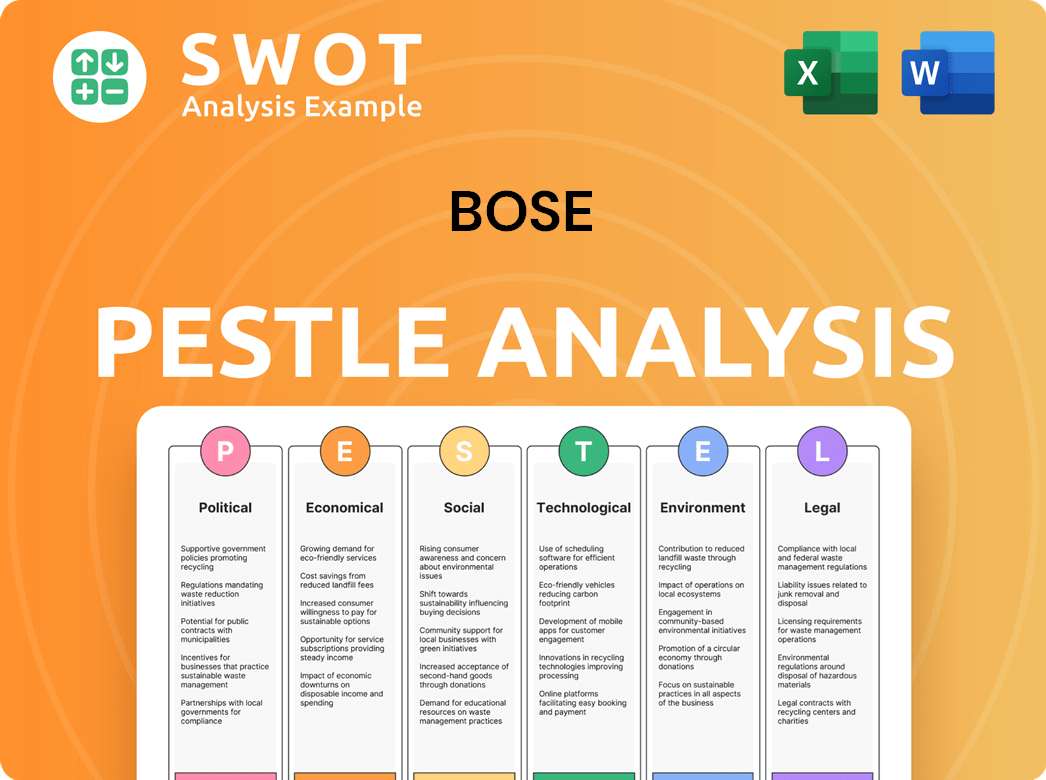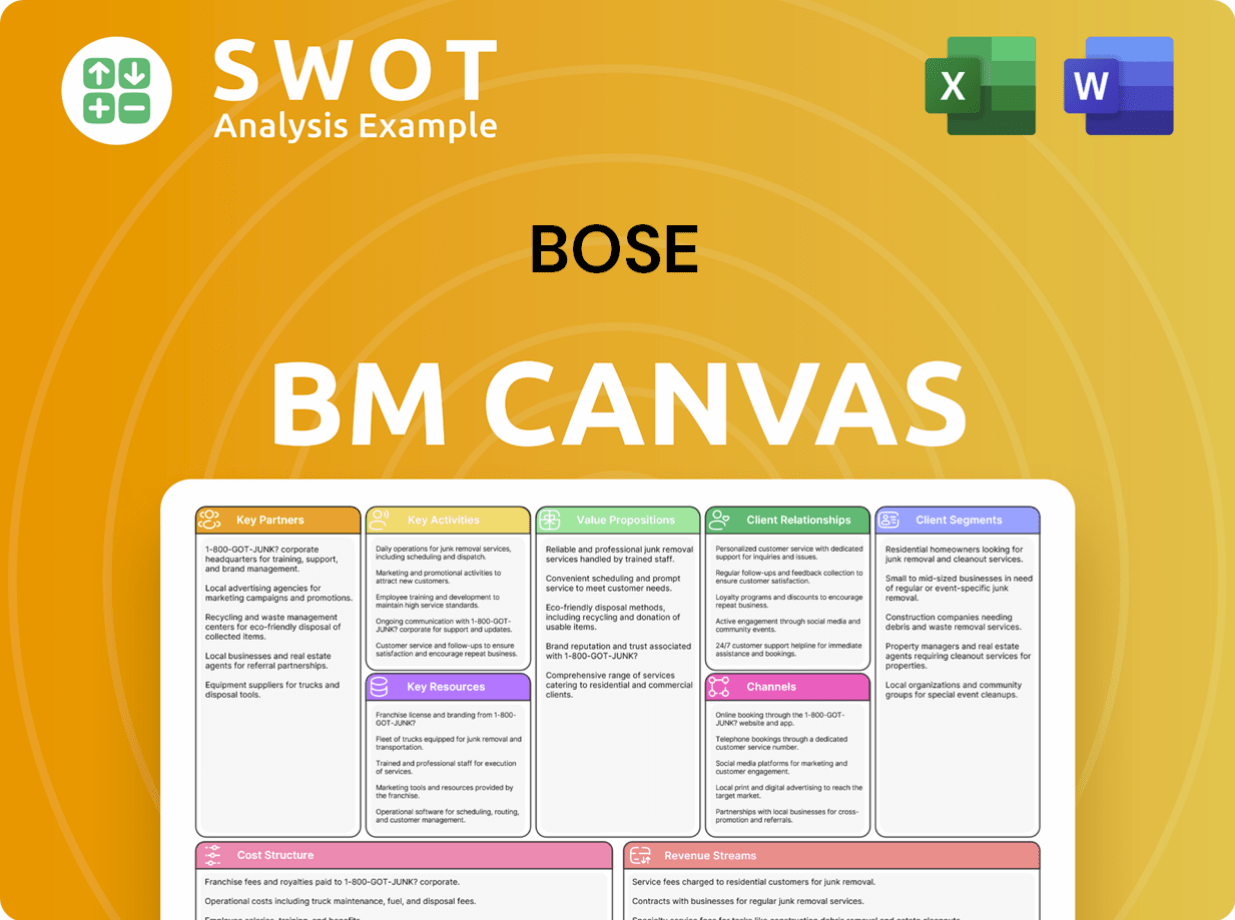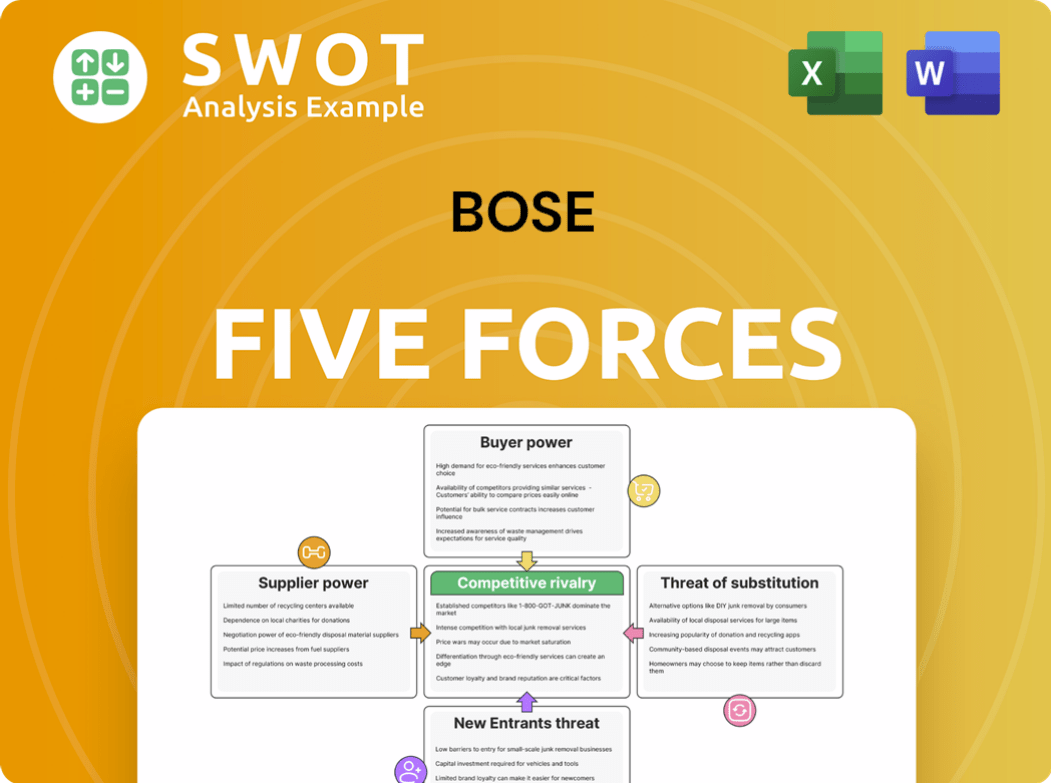Bose Bundle
Who are Bose's Biggest Rivals in the Audio Arena?
Bose, a name synonymous with premium audio, has consistently pushed the boundaries of sound technology since its inception. From its humble beginnings in 1964, the company has become a global powerhouse, known for its innovative approach to acoustics and commitment to customer satisfaction. But in a fiercely competitive market, how does Bose maintain its edge?

This analysis delves into the Bose SWOT Analysis, examining the Bose competitive landscape and identifying key Bose competitors. We will explore the Bose market analysis, including its Bose industry position and its share within the broader Audio market and Headphone market. Understanding the challenges and opportunities facing Bose, including its Bose rival companies, is crucial for anyone seeking to understand the dynamics of this exciting sector.
Where Does Bose’ Stand in the Current Market?
The company holds a strong market position in the audio equipment industry, known for its premium offerings. It operates globally, with a presence in over 150 countries and approximately 190 branded stores. This widespread reach is a key element of its market strategy.
Bose's strategy includes limiting authorized resellers to maintain control over pricing and brand image, ensuring a consistent customer experience. This approach helps in maintaining the brand's premium positioning in the market. The company's focus on high-quality products is a cornerstone of its competitive strategy.
The company has been adapting to market changes by embracing automation in its marketing strategies. This includes applying automation to roughly 90% of its Search and Shopping campaigns. This strategic move aims to increase revenue without significantly increasing marketing expenses. This is a key element of their operational efficiency.
While specific recent market share figures for Bose are not readily available, the home audio equipment market is estimated at around $32.014 billion in 2025. The broader audio equipment market was valued at $38.43 billion in 2024. Bose's emphasis on premium products aligns it with other top brands like JBL and Sony.
In November 2024, Bose acquired McIntosh Group, which includes brands like McIntosh and Sonus faber. This acquisition allows Bose to integrate its research and technology into a wider range of products. This move expands their portfolio and strengthens their position in the luxury audio segment.
Bose competes with other top brands in the audio market, such as JBL and Sony. The company's focus on premium products and brand image helps it stand out. Understanding the Marketing Strategy of Bose provides insights into its competitive approach.
The home audio equipment market is projected to reach approximately $94.230 billion by 2035, growing at a CAGR of 11.4% from 2025 to 2035. The broader audio equipment market is expected to grow to nearly $64.71 billion by 2032, with a CAGR of 6.73% from 2025. These figures highlight the growth potential in the audio industry.
Bose's competitive advantages include its strong brand reputation, premium product offerings, and global presence. The company's focus on innovation and customer experience also contributes to its success. These elements are crucial in the Bose competitive landscape.
- Premium Brand Image
- Global Distribution Network
- Technological Innovation
- Customer-Focused Approach
Bose SWOT Analysis
- Complete SWOT Breakdown
- Fully Customizable
- Editable in Excel & Word
- Professional Formatting
- Investor-Ready Format

Who Are the Main Competitors Challenging Bose?
The Bose competitive landscape is shaped by a dynamic audio market, where innovation and consumer preferences constantly evolve. Understanding the key players is crucial for assessing Bose's position and future prospects. This involves a deep dive into the strategies and offerings of its main rivals.
Analyzing the
Bose faces significant competition in the audio equipment market from a variety of direct and indirect rivals, including established tech giants and specialized audio companies. The
In the noise-canceling headphone segment, Sony's WH-1000XM5 and Apple AirPods Max are strong contenders, often praised for their superior noise cancellation and sound quality. Bose's QuietComfort Ultra headphones are also noted for their captivating sound and class-leading noise cancellation.
For smart speakers, Sonos products and Apple HomePod Mini are key alternatives. These competitors offer integrated smart home features and compete on sound quality and ecosystem integration.
In portable speakers, JBL Boombox 3 and Bang & Olufsen Beolit 20 compete with Bose's offerings. These brands focus on durability, portability, and high-quality audio for outdoor and on-the-go use.
Tech behemoths like Apple and Amazon have entered the audio space, posing a challenge due to their larger ecosystems and extensive resources. Amazon's Alexa division alone employs significantly more staff than Bose.
To remain competitive, Bose is looking outside for innovation and strategic partnerships. In April 2025, Bose reinvested $20 million in Noise, an Indian tech-driven brand in the wearables and audio market, indicating a strategic alliance to build value and scale for the next generation of consumers.
The
Several factors influence the
- Product Quality: Superior sound and noise cancellation are critical for success in the headphone market.
- Innovation: Continuous development of new features and technologies, such as improved wireless connectivity and smart home integration.
- Pricing Strategy: Balancing premium pricing with value to remain competitive against rivals.
- Brand Reputation: Maintaining a strong brand image that resonates with consumers.
- Distribution: Expanding and optimizing distribution channels to reach a wider audience.
Bose PESTLE Analysis
- Covers All 6 PESTLE Categories
- No Research Needed – Save Hours of Work
- Built by Experts, Trusted by Consultants
- Instant Download, Ready to Use
- 100% Editable, Fully Customizable

What Gives Bose a Competitive Edge Over Its Rivals?
Understanding the competitive landscape of the company involves examining its key strengths, strategic initiatives, and market positioning. The company distinguishes itself through its proprietary technologies, strong brand reputation, and continuous innovation in the audio industry. This approach has allowed the company to maintain a competitive edge in a dynamic market.
The company's strategic moves, such as the acquisition of McIntosh Group in November 2024, have expanded its portfolio and market reach. This expansion combines over 175 years of technical expertise and craftsmanship, enhancing its ability to offer premium audio solutions. The company's focus on customer-centric strategies and personalized experiences further strengthens its market position.
The company's competitive advantages are rooted in its technological innovations, brand equity, and customer-focused approach. The company's commitment to innovation, particularly in noise cancellation and immersive audio, has set it apart. The company's strategic acquisitions and marketing strategies further solidify its position in the audio market.
The company's competitive edge is significantly enhanced by its focus on technological innovation. Recent patent filings in 2024 and 2025 highlight advancements in areas such as seatback speakers, headphone designs, and audio amplifiers. These innovations demonstrate the company's commitment to maintaining a leading position in the audio market.
The company's strong brand equity and customer loyalty are key competitive advantages. The company leverages this through a customer-centric approach and personalized experiences. The company's marketing strategies, including the use of marketing automation, enhance its ability to connect with consumers and drive direct-to-consumer revenue growth.
The acquisition of McIntosh Group in November 2024 expanded the company's portfolio into high-performance and luxury audio segments. This strategic move allows the company to integrate its audio research and technology into a broader range of premium solutions. This expansion enhances the company's competitive position in the audio market.
The company's marketing strategy emphasizes a fixed price range, aligning with its commitment to high-quality audio. The company uses marketing automation across approximately 90% of its Search and Shopping campaigns. By focusing on shared passions like music and sports, the company creates deeper cultural connections and resonates with its audience, strengthening its brand positioning.
The company's competitive advantages are multifaceted, encompassing technological innovation, strong brand equity, and strategic market positioning. The company's focus on research and development, combined with a customer-centric approach, allows it to maintain a competitive edge in the audio market. For more details about the company's structure, consider reading about Owners & Shareholders of Bose.
- Proprietary Technologies: The company's innovations in noise cancellation and immersive audio.
- Brand Equity: A strong reputation built on quality and customer trust.
- Strategic Acquisitions: Expanding its portfolio and market reach.
- Customer-Centric Approach: Personalized experiences and marketing strategies.
Bose Business Model Canvas
- Complete 9-Block Business Model Canvas
- Effortlessly Communicate Your Business Strategy
- Investor-Ready BMC Format
- 100% Editable and Customizable
- Clear and Structured Layout

What Industry Trends Are Reshaping Bose’s Competitive Landscape?
The audio equipment industry is currently undergoing significant transformation, driven by technological advancements, evolving consumer preferences, and the increasing demand for high-quality audio experiences. The Bose competitive landscape is shaped by these trends, as well as the strategies of its rivals. The market is projected to grow substantially, with the home audio equipment market alone expected to reach approximately $94.230 billion by 2035, at a Compound Annual Growth Rate (CAGR) of 11.4% from 2025.
Bose market analysis reveals both opportunities and challenges. The rise of 'tech behemoths' like Apple, Sony, and Samsung poses a competitive threat, requiring strategic responses to maintain market share. However, innovation in areas such as immersive audio and automotive sound systems presents avenues for growth and differentiation within the Bose industry. The company's focus on sustainability and strategic acquisitions further shape its future outlook.
Key trends include the increasing preference for high-end goods, rising urbanization, and technological breakthroughs. The growing demand for luxury cars is also fueling the growth of the audio equipment market due to the inclusion of high-quality audio systems in these vehicles. Furthermore, the audio and video equipment market is seeing strong growth due to increased internet penetration and the rising demand for Bluetooth devices, impacting the Bose industry.
The primary challenge is competition from large tech companies with vast resources and integrated ecosystems. Maintaining innovation and adapting to changing consumer preferences are also critical. The need to develop a unified technology infrastructure and address environmental concerns, such as plastic waste, represent additional hurdles for the company. For Bose competitors, staying ahead of the curve is a constant battle.
Continued innovation in immersive audio, noise cancellation, and automotive sound systems provides significant growth potential. Expanding into the luxury audio segment through acquisitions, like the late 2024 purchase of McIntosh Group, and leveraging AI in marketing for personalization are also key opportunities. Focusing on sustainability initiatives can also enhance brand value and appeal to environmentally conscious consumers. The Bose market analysis shows that these opportunities are crucial for future growth.
Investing in software and exploring mergers and acquisitions through Bose Ventures is a strategic move. Developing a unified technology infrastructure for product interoperability and easy upgrades is also critical. Showcasing advancements in in-car audio and focusing on environmental sustainability are other important initiatives. The company's focus on these initiatives will determine its Bose market share 2024 and beyond.
To succeed, Bose must navigate the competitive landscape by focusing on innovation, strategic partnerships, and sustainability. The company's ability to differentiate itself through superior audio quality, advanced features, and a strong brand reputation is crucial. Addressing the challenges posed by larger competitors and capitalizing on emerging opportunities will be key to long-term success.
- Prioritize innovation in areas like immersive audio and automotive sound systems.
- Invest in software and explore strategic acquisitions to expand product offerings.
- Develop a unified technology infrastructure for seamless product integration.
- Focus on environmental sustainability to enhance brand appeal.
- Leverage AI in marketing to personalize customer experiences.
Bose Porter's Five Forces Analysis
- Covers All 5 Competitive Forces in Detail
- Structured for Consultants, Students, and Founders
- 100% Editable in Microsoft Word & Excel
- Instant Digital Download – Use Immediately
- Compatible with Mac & PC – Fully Unlocked

Related Blogs
- What are Mission Vision & Core Values of Bose Company?
- What is Growth Strategy and Future Prospects of Bose Company?
- How Does Bose Company Work?
- What is Sales and Marketing Strategy of Bose Company?
- What is Brief History of Bose Company?
- Who Owns Bose Company?
- What is Customer Demographics and Target Market of Bose Company?
Disclaimer
All information, articles, and product details provided on this website are for general informational and educational purposes only. We do not claim any ownership over, nor do we intend to infringe upon, any trademarks, copyrights, logos, brand names, or other intellectual property mentioned or depicted on this site. Such intellectual property remains the property of its respective owners, and any references here are made solely for identification or informational purposes, without implying any affiliation, endorsement, or partnership.
We make no representations or warranties, express or implied, regarding the accuracy, completeness, or suitability of any content or products presented. Nothing on this website should be construed as legal, tax, investment, financial, medical, or other professional advice. In addition, no part of this site—including articles or product references—constitutes a solicitation, recommendation, endorsement, advertisement, or offer to buy or sell any securities, franchises, or other financial instruments, particularly in jurisdictions where such activity would be unlawful.
All content is of a general nature and may not address the specific circumstances of any individual or entity. It is not a substitute for professional advice or services. Any actions you take based on the information provided here are strictly at your own risk. You accept full responsibility for any decisions or outcomes arising from your use of this website and agree to release us from any liability in connection with your use of, or reliance upon, the content or products found herein.